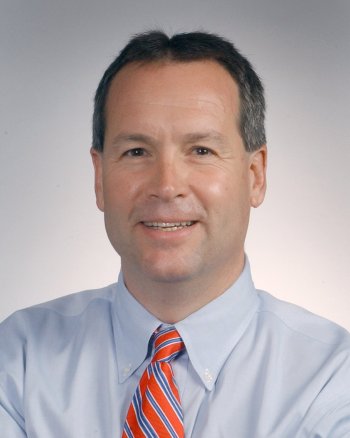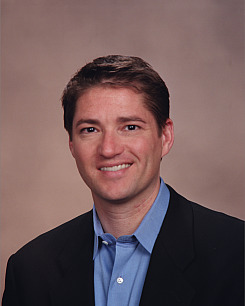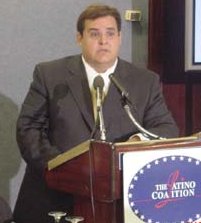Posted by Elena del Valle on March 9, 2006

Eric Shannon, president and founder LatPro
Photo: LatPro
Ft. Lauderdale, Florida — LatPro.com, an employment Web site for professional bilingual talent in the Americas, was chosen as a recipient of Weddle’s Annual User’s Choice Award for 2006, ranking LatPro among the top 30 employment sites online.
More than 30,000 job seekers, recruiters and employers cast ballots in Weddle’s 2006 User’s Choice Award to determine the most outstanding employment sites on the web. Weddle’s has been conducting surveys of recruiters, job seekers and employment-related Web sites since 1996. Through a year-long polling process at Weddles.com, users voted for the sites they felt deliver the best level of service and value.
“We are especially proud to receive this award because it was determined by the employers, recruiters and job seekers who actually use our service,” said Eric Shannon, LatPro president. “Our focus has always been on providing the absolute best user experience, customer service and value for our clients, and we’re pleased that our efforts have been recognized in this way. We want to thank everyone for their votes on our behalf.”
Previously featured in the 2001 print edition of Weddle’s Recruiter’s Guide to Employment Web Sites, LatPro connects employers and recruiters with Spanish and Portuguese speaking professionals within the United States and worldwide. Since 1997, LatPro has provided online employment resources for Hispanic and bilingual professionals. With more than 275,000 members and 90 of the Fortune 100 companies using its service, LatPro is one of the largest diversity employment sites in the U.S. The list of winners may be viewed online at Weddeles.com
Posted by Elena del Valle on March 3, 2006

Jeff Zucker, chief executive officer, NBC Universal Television Group
Photo: NBC Universal
Burbank, California – In a landmark move, NBC Universal Television Group signed a two-year, first-look development deal with Galán Entertainment for the production of telenovelas and other Spanish-language formats in English across its many networks. In contrast to other similar network arrangements, NBC Universal, Galán Entertainment and Telemundo will leverage the existing assets and expertise of the novela (soap opera) production system perfected by Telemundo, the second-largest Spanish language content producer in the United States, for the Spanish language market. Telemundo will license all its formats, in addition to other acquired formats, to Galán Entertainment to re-develop into English.
“This represents a fantastic opportunity to achieve many of our goals at NBCU,” said Jeff Zucker, chief executive officer, NBC Universal Television Group. “With this, we can better integrate our English and Spanish-speaking audiences in a way that no other broadcaster can do. It shows the tremendous promise we first saw when we brought Telemundo into the NBC family.”

Don Browne, president, Telemundo
Photo: Telemundo
“The deal further highlights the value of GE’s and NBCU’s investment in Spanish language television,” said Don Browne, president, Telemundo. “Nely Galán provides the perfect bridge to transport the great development, production and writing talents of the Telemundo team into English language.”

Nely Galán, president, Galan Entertainment
Photo: Galan Entertainment
“It is a dream come true to take the genre I grew up with and be able to cross it over. I expect to see novelas as a staple of American TV,” said Nely Galán, president, Galan Entertainment. “My experience producing programs in both English and Spanish will allow me to fine tune these formats and maximize their impact on the American television audience.”
As part of the deal Gálan Entertainment will re-shape Telemundo and other suppliers’ Spanish language formats for the English market, first for NBC, USA and Bravo, and then for other networks. Galán, who is the former president of Entertainment for Telemundo, has produced more than 600 episodes of television in Spanish and English. Most recently, she created the show “The Swan” for Telemundo.
The first project to be developed for production this summer will be the Telemundo production “Body of Desire,” written by Julio Jimenez. Key players in the Telemundo Studios team are Patricio Wills, head of Telemundo Studios; Marcos Santana, head of development; and Derek Bond, head of production.
Posted by Elena del Valle on March 2, 2006

Gary Bassell, chairman & CEO, The Bravo Group
New York City – Pfizer Consumer Healthcare selected The Bravo Group, a well known Hispanic market agency, as its advertising agency of record for the U.S. Hispanic market. Bravo, which has 20 years of healthcare experience, will develop multi-brand marketing programs for Pfizer Consumer Healthcare.
“Pfizer Consumer Healthcare is committed to building strong relationships with Hispanic consumers,” said Jaime Aranda, director, Ethnic Business Development at Pfizer. “After an agency review, we were persuaded by Bravo’s integrated marketing capabilities, robust strategic planning process, media buying structure and expertise in marketing to Hispanic consumers in this country.”
Pfizer Consumer Healthcare and Bravo are evaluating a full array of marketing practice options facilitated by the agency’s experiential marketing practice including retail and promotional marketing, digital/interactive and direct marketing/crm targeting Spanish-speaking consumers in the United States. Pfizer Consumer Healthcare joins The Bravo Group’s roster of blue chip clients that includes Cingular, Sears, Mazda, Kraft Foods, ChevronTexaco, Miller Brewing Company, Visa, Microsoft, Hertz, U.S. Postal Service, The New York Times and Time Warner Cable.
“Healthcare marketing to Hispanic consumers is uncommonly rewarding,” explained Gary Bassell, chairman and CEO of The Bravo Group. “It’s an area where acute planning insights can be effectively leveraged, dimensionalized brand experiences developed utilizing a range of marketing practices and the team instilled with a sense that work with a meaningful benefit is being done for the market.”

De Jesús-Cutler, president & COO, The Bravo Group
“One of the fastest growing segments in the Hispanic market is healthcare, and Pfizer, a Fortune 500 leading healthcare company, has long recognized the contributions Hispanics have made to their business,” said Linda De Jesús-Cutler, president and COO, The Bravo Group. “We look forward to partnering with them and building on their success,” she added.
The Consumer Healthcare Division of Pfizer Inc., headquartered in Morris Plains, New Jersey, is described as the world’s second-largest consumer healthcare company, with a portfolio of market-leading brands that include Benadryl®, Listerine Antiseptic Mouthwash®, Neosporin®, Sudafed®, Visine®, and Zantac®. The Bravo Group, a Young & Rubicam Brands company, is a pioneer agency of Hispanic marketing that continues to be a leader today among U.S. Hispanic integrated communications agency groups after 25 years in the U.S. Hispanic market.
Established in 1980, The Bravo Group has created award-winning marketing programs that include research and strategic planning; advertising, interactive/digital, direct, promotional and event marketing; media planning/buying; branded entertainment and public relations. Recognized in 2005 as one of the two largest Hispanic agencies in the U.S. by Advertising Age, the company is headquartered in New York and has offices in San Francisco, Chicago, Miami and Irvine, California.
Posted by Elena del Valle on February 24, 2006
By Elena del Valle, president, LNAWorld Communications
There is good news for Hispanic families on a budget searching for a way to pay for higher education costs: College bound Hispanics can benefit from increasing scholarship opportunities. This year, Hispanic students have a wealth of scholarship options. Just as frenzied students are selecting college programs or planning their return to school, many Hispanic organizations are announcing scholarship funding programs and guidelines for the school year beginning this fall.
Click here to read the entire article and for a list of scholarships
Posted by Elena del Valle on February 14, 2006

César M. Melgoza, president and and CEO, Geoscape International, Inc.
Geoscape’s newly unveiled 2006 geo-demographic database findings illustrate thousands of powerful facts from across the nation at micro and macro levels of geography. The summary report confirms the continuing growth of Hispanic markets and outlines the areas of greatest interest for marketers. For example, the report indicates that the Hispanic population significantly out-paces Non-Hispanic White population growth in all metropolitan areas; at the same time, in many areas Non-Hispnaic White growth is negative during the period reviewed. The findings also indicate that Charlotte is the leader in percentage gain for Hispanic population growth during the period studied, followed by Atlanta, Nashville and Raleigh.
“Geoscape is the only company that provides deep multicultural data, along with various other types of spending, behavior, media and direct marketing data-through a powerful and friendly interface,” said César M. Melgoza, president and and CEO, Geoscape International, Inc.
The report indicates that Mexican origin Hispanics form the majority of Hispanics in the U.S. followed by Puerto Ricans, Cubans, Dominicans and Salvadorans. The proportion of Mexicans among Hispanics has continued to increase. The mix of Hispanic countries of origin varies considerably among states; Florida and New York especially are home to a majority of Caribbean Hispanics. Regarding language use in 2006 the report says: “The vast majority of Hispanics are Bi-Lingual to some degree; and nearly equal quantities are dependent on either English or Spanish.”
The American Marketscape DataStream: 2006 Series (AMDS) features detailed records on all sectors of the American populace and consumer spending. AMDS is made up of a team of specialized demographers, statistical modelers and database programmers built from the ground, truth upward, households to block groups to metro areas and the nation for optimal accuracy. It is published at eight levels of geographic units, block group, census tract, zip code, county, metro area, DMA, state and nation.
Some of the Hispanic market highlights in the AMDS 2006 Executive Summary Report include:
- Hispanics in 2006 number 44.2 million and are expected to surge to 51.4 million by 2011
- 297 counties, including the largest in the nation, are “majority-minority”
- Major cities in the southeastern U.S., such as Charlotte, Atlanta and Nashville, have seen the most dramatic Hispanic growth
- The vast majority of Hispanics are bilingual, 83 percent nationwide
- Bilingual to English-dependent form 62 percent of the age 5 plus Hispanic population
- Bilingual to Spanish-dependent form 57 percent of the age 5 plus Hispanic population
- AMDS Hispanicity™ Segments show that only 5 percent of Hispanics are fully assimilated to the U.S.
- AMDS Hispanicity™ Segments show that 78.6 percent of Hispanics are either bicultural or unacculturated
- More than one third of Hispanic households earn over $50,000 per year
- Hispanic spending on automobiles and other transportation will reach nearly $70 billion in 2006
- African Americans will spend about $75 billion on homes/shelter in 2006
- Asian households will spend nearly $30 billion on pensions and insurance in 2006
- Asian/Pacific Islanders will surpass 13 million in 2006
- African Americans will number nearly 36 million in 2006
The Executive Summary Report profiles for the nation’s “Top 10 Multicultural DMAs” illustrate the dramatic population shifts from 1990 to 2011. Asians, Blacks & Hispanics accounted for more than 70 percent of population growth and Hispanics accounted for more than 50 percent since 2000. By 2011 the population in the three largest ethnic groups will be more than 107 million and Hispanics will represent nearly half of that population. On July 1, 2006 America will have 113.5 million households. Of this total, nearly 13 million will be Hispanic, nearly 11.5 million African American and nearly 4 million Asian. California remains the largest state and Wyoming the smallest in terms of households. The AMDS 2006 Executive Summary Report is available at Geoscape
Posted by Elena del Valle on February 13, 2006

Juan Ochoa, director of Program Development, MFM Trade Meetings
Photo: MFM Trade Meetings
A podcast featuring an interview with Juan Ochoa, director of Program Development at MFM Trade Meetings, is available in the Podcast Section of Hispanic Marketing & Public Relations, HispanicMPR.com. During the podcast, Juan discusses in detail the upcoming Fourth Annual Innovations in Hispanic Marketing Conference to be held in Miami, March 14-16, 2006 with Elena del Valle, host of the HispanicMPR.com podcast.
Juan has worked in the events sector for more than six years and has been with the MFM Group since March of 2004. He leads the production processes for the events division of MFM Trade Meetings. Juan, who selects speakers and handles speaker relationships, researches and develops business conferences for targeted audience segments and high level corporate executives. He has developed the MFM Hispanic Marketing, Entertainment & Media, and Youth Marketing events.
To listen to the interview, scroll down until you see the “Podcast” on the right hand side, then select “HMPR Juan Ochoa,” hit the play button or download it to your iPod or MP3 player to listen on the go, in your car or at home. To download it, click on the arrow of the recording you wish to copy and save to disk. The podcast will remain listed in the February 2006 section of the podcast archive.
Posted by Elena del Valle on February 10, 2006

David Drummond, director of marketing, National Gypsum
Photo: National Gypsum
Charlotte, North Carolina – National Gypsum, a leading manufacturer of gypsum wallboard and related products, launched a Spanish version of its award winning website. The website offers Spanish speaking construction professionals information about the company’s products and resources, including Material Safety Data Sheets (MSDS), submittals, guide specifications and product literature.
National Gypsum, its executives say, is the first company in the gypsum industry to offer its users all of its online resources in Spanish. In 1995, National Gypsum was also the first gypsum company to debut a website that introduced its products and resources on the Internet. The company enlisted the help of Enventys Latino Market Solutions, a fully integrated product and business development firm, and Vialogix, developers and designers of National Gypsum’s award-winning website.
“Vialogix helped us extend our original site architecture, which our customers have told us they like using due to its ease of use, to our new Spanish language site. Enventys’ expertise was invaluable in specifically tailoring the content of this site to this important, fast growing customer segment,” said David Drummond, director of Marketing at National Gypsum. “The Hispanic labor force is a very important part of our industry. By providing our website in Spanish we want to be the destination of choice for Hispanic construction workers looking for product information and want them to see National Gypsum as a partner throughout their career.”
The Hispanic portion of the U.S. labor force has increased rapidly over the last decade, particularly in construction, which has a larger share of Hispanic workers than any industry, except agriculture. According to the Pew Hispanic Center, 24 percent of construction workers are Hispanic. The number of Hispanic construction workers quadrupled in the last two decades.
“National Gypsum just made a major step in reaching out to the Hispanic construction professional,” said Alfredo Garza, director of Hispanic Marketing at Enventys. Some estimates already put the number of U.S. Hispanics online at 12.4 million and growing 15 to 20 percent annually, four times faster than in the general population. “I really believe that they will be rewarded with the loyalty of Hispanic customers for taking the lead with this important initiative.”
“National Gypsum has made a conscious effort to listen to customer feedback and deliver a consistent user experience across all its web properties. The Spanish language site caters to an important audience and continues the National Gypsum trend of giving customers the information they need to make intelligent purchasing decisions,” said Rob Norris, president of Vialogix.
National Gypsum is a fully integrated manufacturer and supplier of building products used worldwide. Primary emphasis is on Gold Bond(R) brand gypsum wallboard, ProForm(R) brand interior finishing products, and PermaBase(R) brand cement board, in addition to a new XP family of abuse, impact, mold and moisture resistant products. Based in Charlotte, North Carolina National Gypsum is privately held and operates more than 40 facilities throughout the United States and Canada. The website can be accessed at NationalGypsum.com/espanol or by clicking the link Espanol on the website NationalGypsum.com.
Posted by Elena del Valle on February 9, 2006

Steve Gaspar, president, VMH VideoMovieHouse.com Inc.
Photo: VMH VideoMovieHouse.com
Vancouver, British Columbia – VMH VideoMovieHouse.com Inc. (VMH) and Centaurus Media Group & Associates Inc. (CMG) agreed to form a strategic partnership between the two companies and to develop a jointly funded marketing plan to target the North American Hispanic marketplace by introducing VideoMovieHouse.com and its fully owned subsidiary DVDMarketplace.com into the Latino Community. Initially, CMG plans to develop and implement a pilot project focusing its marketing efforts towards the large Hispanic community in the South Florida Region. Once successful, CMG aims to expand its marketing efforts towards other Hispanic markets nationwide; develop distribution channels in the southeast region with hopes of setting up of a distribution facility in Southern Florida; and aid in the development of Hispanic versions of the DVDmarketplace.com and Videomoviehouse.com websites.
“Focusing on the Hispanic market has been an easy decision for our company to make. Hispanic Americans are rapidly becoming the predominant culture in the United States and the bi-lingual Hispanic community is the fastest growing segment of the U.S economy,” said Steve Gaspar, president of VMH VideoMovieHouse.com, Inc. (OTCBB:VMHVF). “Research shows Latinos are generally more aggressive DVD purchasers than the rest of the U.S population. Surveys show that 54 percent of Latinos buying DVDs purchase two or more at a time compared to the general population’s 42 percent. Therefore, it makes good business sense to team up with a media and marketing powerhouse such as CMG to help us to showcase our company to the Latino community and other ethnic communities nationwide.”
Jeronimo Terife, president of Centaurus Media Group & Associates, Inc.
Photo: CMG
“CMG has plans of introducing DVDMarketplace.com and VideoMovieHouse.com into the Hispanic community worldwide. We feel we can penetrate markets previously untapped by VMH and our South Florida marketing initiative will be the first step towards globalizing the DVDMarketplace and VideoMovieHouse.com brands,” said Jeronimo Terife, president of Centaurus Media Group & Associates, Inc. “South Florida is the home of the most diverse Hispanic community in the world. Our prime objective is to facilitate VMH’s market penetration into Latino communities throughout the U.S.A., South America, Central America, Spain, and other regions previously untapped by VMH. The Latino community is the fastest growing segment of the U.S economy and the opportunity for VMH to benefit is enormous. Our job is to turn VMH’s traffic into sales and brand recognition. The Hispanic consumer has proven loyal to the brand.”
VMH VideoMovieHouse.com, (OTCBB: VMHVF) is an online seller and renter of DVDs worldwide operating websites under the DVDMarketplace.com and VideoMovieHouse.com banners. The company intends to concentrate its near term expansion efforts toward the third party e-merchant business, commencing with DVDs and expanding to other media products as opportunities present themselves. VideoMovieHouse.com is planning a national advertising campaign rollout with aims of creating one of the world’s largest interactive DVD Buyer/Seller communities. More information about the company is available at VideoMovieHouse.com
Centaurus Media Group & Associates Inc. is a recent fusion between Centaurus Productions Inc., Image Consulting USA Inc., Global Media Equipment Corp., Lights Up Productions Inc., Terrific Entertainment Inc., WRI Web results., Handle Like Eggs Productions Inc., and Spots Inc., gathering more than 20 years of experience in the various fields of media production. CMG is a media company with worldwide expertise in the fields of audio visual services, corporate events, theatrical performances, concerts, radio and television production as well as video and music production.
CMG produces corporate videos, training videos, Radio advertising and Television commercials, jingles, 3D and 2D animations, interactive CD roms, websites, fashion photography, graphic design, ad designs for stationary products such as news papers, magazines and brochures, as well as production of live radio and Television programs. CMG’s partial list of clients includes Coca-Cola, Burger King, General Motors, AT&T, Johnson & Johnson, Mercedes Benz, Revlon, Billboard Latino Music Awards, Pfizer, NBC, Bank of America, Bayer, Pepsi, Novartis, Sony Music, NFL, Tommy Hilfiger, IBM, Miami Dolphins, Visa, Honda, Latin Grammy Awards, Ameriquest Mortgage, Glaxo Smith Kline, Estee Lauder, Univision, Citigroup, Disney Channel, Kellogg’s, McDonalds, AstraZeneca, FIFA, UBS, A&E Mundo, L Oreal, Audi, Discovery Channel, and The History Channel. For further information about the company is available at CMG
Posted by Elena del Valle on February 6, 2006
Nacho Hernandez, CEO and founder, iHispanic Marketing Group
Seattle, Washington – Global Market Insite, Inc., GMI, a leading provider of global market intelligence solutions, expanded its Hispanic online panel through a strategic partnership with iHispanic Marketing Group, a leading search marketing and Internet strategy company based in La Jolla, California. The company’s Web presence among the U.S. Hispanic population and an extensive network of affiliates throughout Latin America, executives hope, will enable GMI to recruit new Hispanic online panelists in both regions.
According to a 2004 study by eMarketer, there will be 16 million Hispanic Internet users in the U.S. by 2007, representing 8.4 percent of all users. At the same time, Latin America ranks fourth among total worldwide Internet users; the target demographic, aged 18 to 34 years old, is considered by many the most dynamic segment of the Hispanic online population.

Jim Weisfield, vice president of business development, GMI
“The explosive increase in the U.S. Hispanic population, coupled with its purchasing power, has companies competing for substantial market share of this largely untapped market,” said Jim Weisfield, vice president of business development for GMI. “Adding new consumers to our panel through iHispanic will enable us to better respond to the real-time insights that market research firms and Global 2000 corporations need.”
“We are very pleased to contribute to enhancing the world’s largest, highly-profiled, double opt-in managed panel,” said Nacho Hernandez, CEO and founder of iHispanic Marketing Group. “Our knowledge of the Hispanic online community will enable GMI to go to market quicker with enhanced panel capabilities, ensure higher panel retention and reach high return on investment.”
GMI provides comprehensive integrated solutions for global market intelligence for market research firms and corporate market research departments at Global 2000 companies. Founded in 1999 with world headquarters in Seattle, Washington GMI has operations on five continents. More information is available at GMI.
The iHispanic Marketing Group generates competitive business and marketing solutions for web site owners that target the U.S. Hispanic market and Latin America. The company maintains strong associations with the Search Engine Marketing Professionals Organization (SEMPO), the Search Marketing Association of North America (SMA-NA) and IAB Mexico. More information is available at iHispanic,
Posted by Elena del Valle on January 24, 2006

Robert Deposada, president of the The Latino Coalition
Washington, D.C. — The debate over immigration reform appears to be one of the hottest issues in the upcoming elections. When asked what party they identify with, Democrats outpaced Republicans by a margin of 58 percent to 23 percent, compared to a margin of 52 percent to 29 percent last year according to the recently released results of the 2005 National Latino Survey by The Latino Coalition, TLC. The say results indicate that if the midterm congressional elections were held today, Democrats would win overwhelmingly with a margin of 61 percent to 21 percent, compared to last year’s 56 percent to 30 percent.
"This survey has become the most reliable and accurate study on Hispanic political and consumer behavior in the U.S. The 2004 National Latino Survey was dead-on accurate in predicting the Latino vote in the 2004 elections," said TLC President Robert Deposada. "We predicted the nine-point spread between Senator Kerry and President Bush, while all other surveys predicted a Kerry win of over 30 points. The results of this year’s survey offer similar surprising results and highlight the future trends of Latino adults and Latino voters in the U.S. However, contrary to past years these trends spell trouble for the Republican Party."
"This survey shows there are two very different segments within the Hispanic community: recent immigrants and those who have been here for years," Deposada added. "Those who have been here longer tend to mostly speak English, are registered voters, are in better financial status, and tend to be more focused on issues that affect their pocket books like taxes, education and health care. The more recent immigrants tend to have lower incomes, speak mostly Spanish only and are more concerned over immigration policies and language barriers. Their views on political issues are many times at odds. Politicians from both political parties need to understand these differences and the diversity within the Latino community if they want to successfully reach out to these voters and future voters."
The national Hispanic survey was conducted among 1,000 Hispanic adults by Latino Opinions between December 10-13, 2005. All interviews were conducted by professional English and Spanish speaking interviewers via telephone. Respondents were given the option of conducting the survey in English or Spanish. Interview selection was at random within predetermined population units. These units were structured to statistically correlate with the nation’s adult Hispanic population according to the 2004 U.S. Census estimates. The accuracy of this national survey of 1,000 Hispanic adults is within plus or minut 3.1 percent at a 95 percent confidence interval.
"Hispanic registered voters are strongly supporting initiatives to reform immigration while penalizing illegal behavior. A majority of Hispanic voters (52.4 percent) support initiatives that would not allow people who entered this county illegally to become citizens unless they reapply from their country of origin," Deposada said. "By a margin of 50 percent to 41 percent, Hispanic voters support increasing the number of border patrol agents in our southern border, and also support new laws to make sure that employers can only hire workers who are in the U.S. legally (50 percent to 41 percent). An overwhelming majority of 82 percent support the creation of a new Temporary Worker Program. Also a plurality (41.2 percent to 39.9 percent) support imposing a fine of at least $2,000 for illegal immigrants in order to gain legal employment as a temporary worker in the U.S."
"Meanwhile, non-registered Latinos have completely different views on these issues," Deposada added. "They overwhelmingly oppose laws to make sure that employers can only hire legal immigrants (65 percent to 28 percent); oppose increasing the number of border patrol agents along our southern border (61 percent to 29 percent); and they support allowing illegal immigrants to have access to citizenship (50 percent to 40 percent)."
"While there has been enormous progress for the Republican Party under President George W. Bush, there is real danger for a repeat of the Pete Wilson era that alienated Hispanics from the GOP for years," Deposada added. "If the Republican leadership in Congress allows an extremist group to control the debate over immigration reform and put partisan rhetoric over real commonsense legislation, the GOP will eliminate all the progress achieved by President Bush in attracting Hispanics into the GOP."
"The Republican leadership in Congress has failed miserably in keeping the coattails of President Bush among Hispanic voters," Deposada said. "When compared to last year’s number on the question of who does a better job at handling key issues, Democrats in Congress kept the same level of support John Kerry had and improved on it, while Republicans cut the numbers in half compared to President Bush."
Following are some survey questions and the corresponding response percentages:
"Creating more jobs and improving the economy"
- Republicans in Congress (2005): 19 percent
- Democrats in Congress (2005): 50 percent
- President Bush (2004): 34 percent
- John Kerry (2004): 54 percent
"Improving Education"
- Republicans in Congress (2005): 20 percent
- Democrats in Congress (2005): 50 percent
- President Bush (2004): 35 percent
- John Kerry (2004): 52 percent
"Providing more affordable health care"
- Republicans in Congress (2005): 15 percent
- Democrats in Congress (2005): 55 percent
- President Bush (2004): 30 percent
- John Kerry (2004): 52 percent
"Representing your views on immigration"
- Republicans in Congress (2005): 17 percent
- Democrats in Congress (2005): 46 percent
- President Bush (2004): 35 percent
- John Kerry (2004): 43 percent
"Keeping America safe and fighting terrorism"
- Republicans in Congress (2005): 30 percent
- Democrats in Congress (2005): 30 percent
- President Bush (2004): 50 percent
- John Kerry (2004): 36 percent
"Being in touch with the Hispanic community"
- Republicans in Congress (2005): 16 percent
- Democrats in Congress (2005): 57 percent
- President Bush (2004): 37 percent
- John Kerry (2004): 37 percent
"The Republican Party is rapidly losing all the gains they achieved under President Bush in the Hispanic community," Deposada added. "If the GOP wants to remain competitive among Hispanic voters, they need to wage an all out effort to regain the momentum."
Senator Hillary Clinton enjoys a favorable rating among Hispanics (56 percent to 10 percent), and is heavily favored in the Democratic primary for president over Senator John Kerry in 2008 (48 percent to 15 percent). Not all is bad news for Republicans. The survey shows that Hispanic voters remain conservative on social and economic issues: By a margin of 44 percent to 9 percent, Hispanics support reducing taxes on families and businesses as the best way to grow the economy and create jobs for average Americans; by a margin of 51 percent to 30 percent Hispanic voters oppose raising taxes on remittances and money transfers in order to pay for indigent health care; by a margin of 55 percent to 35 percent, Hispanic voters would prefer to be covered by a private health care plan over a government-run program like Medicaid; by a margin of 57 percent to 27 percent Hispanics identify themselves as pro-life; by a margin of 57 percent to 36 percent Hispanics support laws to require parental notification before underage teenagers can get an abortion; and, 62 percent oppose gay marriages.
The Latino Coalition is a non-profit, non-partisan organization based in Washington, D.C. established to address policy issues that directly affect the well-being of Hispanics in the United States. Its mission is to develop and promote policies that will foster economic equivalency and enhance overall business, economic, and social development of Hispanics. For more detailed information on the survey and to review past surveys, visit The Latino Coalition
























